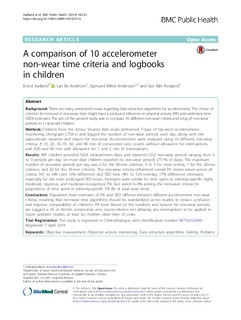| dc.contributor.author | Aadland, Eivind | |
| dc.contributor.author | Andersen, Lars Bo | |
| dc.contributor.author | Anderssen, Sigmund Alfred | |
| dc.contributor.author | Resaland, Geir Kåre | |
| dc.coverage.spatial | Norway | nb_NO |
| dc.date.accessioned | 2019-01-18T12:23:31Z | |
| dc.date.available | 2019-01-18T12:23:31Z | |
| dc.date.created | 2018-04-09T14:00:12Z | |
| dc.date.issued | 2018 | |
| dc.identifier.citation | Aadland, E., Andersen, L. B., Anderssen, S. A., & Resaland, G. K. (2018). A comparison of 10 accelerometer non-wear time criteria and logbooks in children. BMC Public Health, 18(1). | nb_NO |
| dc.identifier.issn | 1471-2458 | |
| dc.identifier.uri | http://hdl.handle.net/11250/2581300 | |
| dc.description.abstract | Background There are many unresolved issues regarding data reduction algorithms for accelerometry. The choice of criterion for removal of non-wear time might have a profound influence on physical activity (PA) and sedentary time (SED) estimates. The aim of the present study was to compare 10 different non-wear criteria and a log of non-wear periods in 11-year-old children. Methods Children from the Active Smarter Kids study performed 7-days of hip-worn accelerometer monitoring (Actigraph GT3X+) and logged the number of non-wear periods each day, along with the approximate duration and reason for non-wear. Accelerometers were analyzed using 10 different non-wear criteria: ≥ 10, 20, 30, 45, 60, and 90 min of consecutive zero counts without allowance for interruptions, and ≥60 and 90 min with allowance for 1 and 2 min of interruptions. Results 891 children provided 5203 measurement days, and reported 1232 non-wear periods ranging from 0 to 3 periods per day: on most days children reported no non-wear periods (77.1% of days). The maximum number of non-wear periods per day was 2 for the 90-min criterion, 3 to 5 for most criteria, 7 for the 20-min criterion, and 20 for the 10-min criterion. The non-wear criteria influenced overall PA (mean values across all criteria: 591 to 649 cpm; 10% difference) and SED time (461 to 539 min/day; 17% difference) estimates, especially for the most prolonged SED bouts. Estimates were similar for time spent in intensity-specific (light, moderate, vigorous, and moderate-to-vigorous) PA, but varied 6–9% among the non-wear criteria for proportions of time spent in intensity-specific PA (% of total wear time). Conclusions Population level estimates of PA and SED differed between different accelerometer non-wear criteria, meaning that non-wear time algorithms should be standardized across studies to reduce confusion and improve comparability of children’s PA level. Based on the numbers and reasons for non-wear periods, we suggest a 45 or 60-min consecutive zero count-criterion not allowing any interruptions to be applied in future pediatric studies, at least for children older than 10 years. Trial Registration The study is registered in Clinicaltrials.gov with identification number NCT02132494. Registered 7 April 2014. | nb_NO |
| dc.language.iso | eng | nb_NO |
| dc.publisher | BioMed Central | nb_NO |
| dc.rights | Navngivelse 4.0 Internasjonal | * |
| dc.rights.uri | http://creativecommons.org/licenses/by/4.0/deed.no | * |
| dc.title | A comparison of 10 accelerometer non-wear time criteria and logbooks in children | nb_NO |
| dc.type | Journal article | nb_NO |
| dc.type | Peer reviewed | nb_NO |
| dc.description.version | publishedVersion | nb_NO |
| dc.rights.holder | © The Author(s). 2018 | nb_NO |
| dc.subject.nsi | VDP::Samfunnsvitenskap: 200::Samfunnsvitenskapelige idrettsfag: 330::Aktivitetslære: 332 | nb_NO |
| dc.source.pagenumber | 9 | nb_NO |
| dc.source.volume | 18 | nb_NO |
| dc.source.journal | BMC Public Health | nb_NO |
| dc.source.issue | 323 | nb_NO |
| dc.identifier.doi | 10.1186/s12889-018-5212-4 | |
| dc.identifier.cristin | 1578368 | |
| cristin.unitcode | 203,5,2,0 | |
| cristin.unitname | Avdeling for lærarutdanning og idrett - Sogn og Fjordane | |
| cristin.ispublished | true | |
| cristin.fulltext | original | |
| cristin.qualitycode | 1 | |

